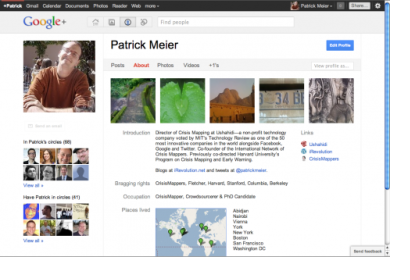Facebook is increasingly used to crowdsource crisis information and response, as is Twitter. So is it just a matter of time until we see similar use cases with Google+? Another question I have is whether such uses cases will simply reflect more of the same or whether we’ll see new, unexpected applications and dynamics? Of course, it may be premature to entertain the role that Google+ might play in disaster response just days after it’s private beta launch, but the company seems fully committed to making this new venture succeed. Entertain-ing how Google+ (G+) might be used as a humanitarian technology thus seems worthwhile.
The fact that G+ is open and searchable is probably one of the starkest differences with the walled-garden that is Facebook; that, and their Data Liberation policy. This will make activity on G+ relatively easier to find—Google is the King of Search, after all. This openness will render serendipity and synergies more likely.
The much talked about “Circles” feature is also very appealing for the kind of organic and collaborative crowdsourcing work that we see emerging following a crisis. Think about these “Circles” not only as networks but also as “honeycombs” for “flash” projects—i.e., short-term and temporary—very much along the lines that Skype is used for live collaborative crisis mapping operations.
Google+’s new Hangout feature could also be used instead of Skype chat and video, with the advantage of having multi-person video-conferencing. With a little more work, the Sparks feature could facilitate media monitoring—an important component of live crisis mapping. And then there’s Google+ mobile, which is accessible on most phones with a browser and already includes a “check-in” feature as well as geo-referenced status updates. The native app for the Android is already available and the iPhone app is coming soon.
Clicking on my status update above, produces the Google Maps page below. What’s particularly telling about this is how “underwhelming” the use of Google Maps currently is within G+. There’s no doubt this will change dramatically as G+ evolves. The Google+ team has noted that they already have dozens of new features ready to be rolled out in the coming months. So expect G+ to make full use of Google’s formidable presence on the Geo Web—think MapMaker+ and Earth Engine+. This could be a big plus for live crowdsourced crisis mapping, especially of the multimedia kind.
One stark difference with Facebook’s status updates and check-in’s is that G+ allows you to decide which Circles (or networks of contacts) to share your updates and check-in’s with. This is an important difference that could allow for more efficient information sharing in near real-time. You could set up your Circles as different teams, perhaps even along UN Cluster lines.
As the G+ mobile website reveals, the team will also be integrating SMS, which is definitely key for crisis response. I imagine there will also be a way to connect your Twitter feed with Google+ in the near future. This will make G+ even more compelling as a mobile humanitarian technology platform. In addition, I expect there are also plans to integrate Google News, Google Reader, Google Groups, Google Docs and Google Translate with G+. GMail, YouTube and Picasa are already integrated.
One feature that will be important for humanitarian applications is offline functionality. Google Reader and GMail already have this feature (Google Gears), which I imagine could be added to G+’s Stream and perhaps eventually with Google Maps? In addition, if Google can provide customizable uses of G+, then this could also make the new platform more compelling for humanitarian organizations, e.g., if OCHA could have their own G+ (“iG+”) by customizing and branding their G+ interface; much like the flexibility afforded by the Ning platform. One first step in that direction might be to offer a range of “themes” for G+, just like Google does with GMail.
Finally, the ability to develop third party apps for G+ could be a big win. Think of a G+ store (in contrast to an App Store). I’d love to see a G+ app for Ushahidi and OSM, for example.If successful, G+ could be the best example of “What Technology Wants” to date. G+ is convergence technology par excellence. It is a hub that connects many of Google’s excellent products and from the looks of it, the G+ team is just getting warmed up with the converging.
I’d love to hear from others who are also brainstorming about possible applications of Google+ in the humanitarian space. Am I off on any of the ideas above? What am I missing? Maybe we could set up a Google+ 4 Disaster Response Circle and get on Hangout to brainstorm together?

